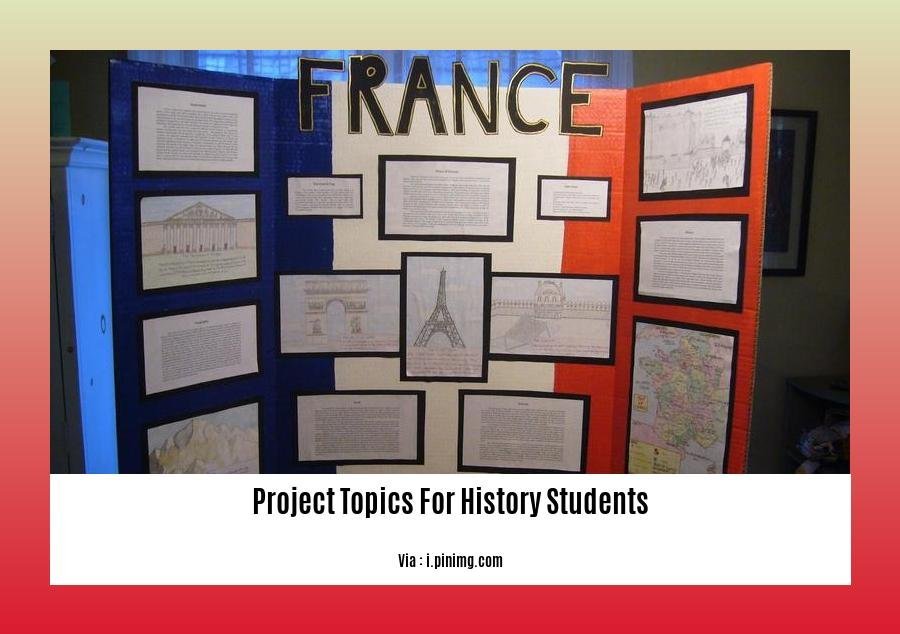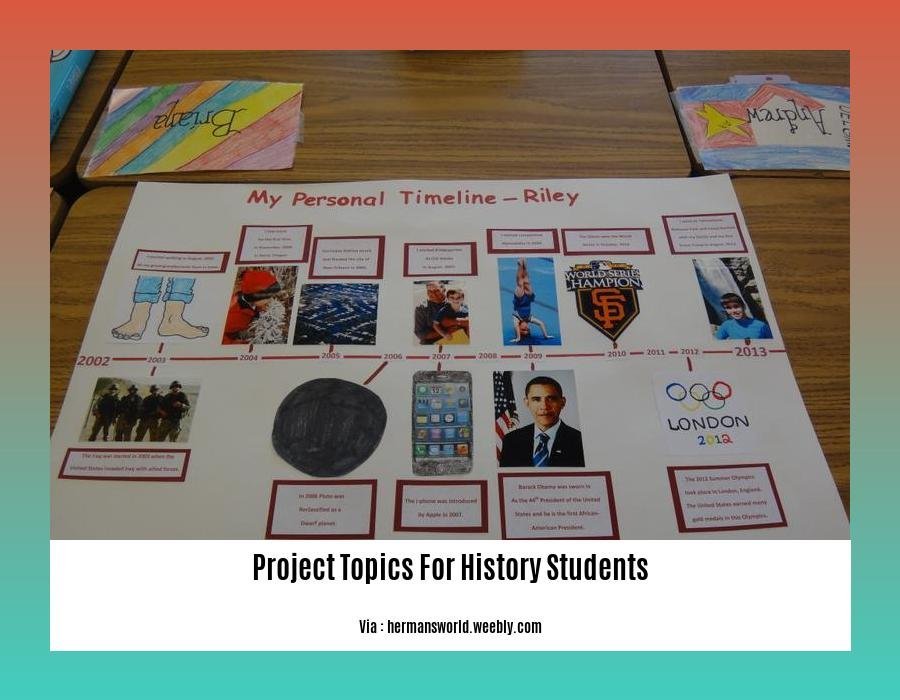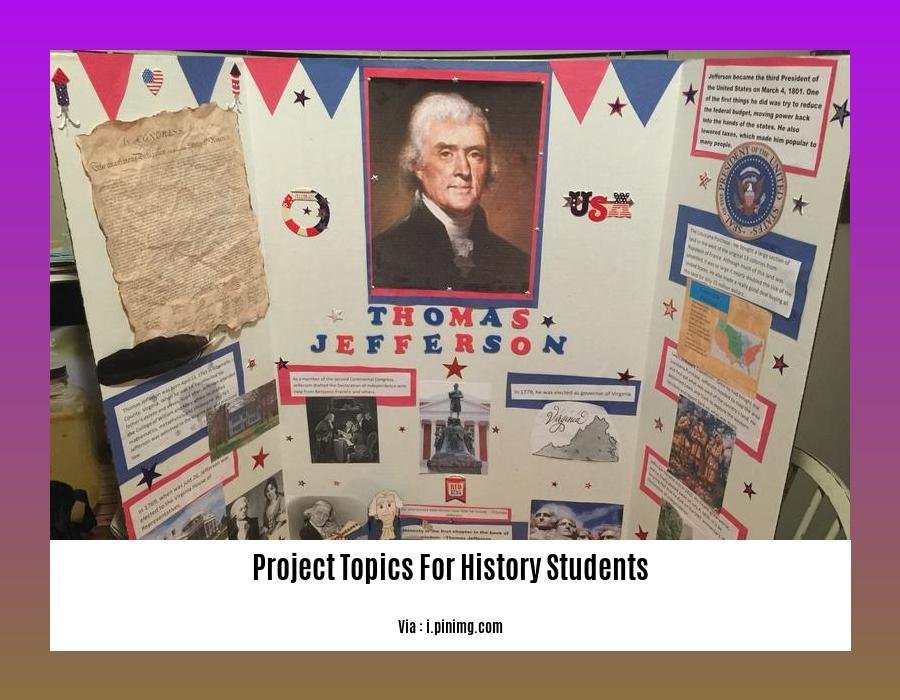Delve into the enthralling world of history with a diverse array of project topics that will challenge your perspectives and analytical skills. “Project Topics for History Students: Exploring Diverse Perspectives and Analyzing the Past” offers a treasure-trove of engaging themes to ignite your curiosity and unlock the secrets of the past. Prepare to embark on an intellectual journey that will leave an indelible mark on your understanding of humanity’s rich tapestry.
Key Takeaways:
Examine the lives and reigns of the young emperors who ruled ancient Rome.
Uncover the intriguing details surrounding the construction of the enigmatic Sphinx.
Explore the origins and development of African tribal cultures.
Immerse yourself in the mystical world of the ancient Mayans and their rich civilization.
Investigate the prominent cultures that flourished in the Nile Valley and their contributions to history.
Study the significance of ziggurats in ancient Mesopotamia and their role in religious and cultural practices.
Analyze the strategies employed by Alexander the Great in his conquest of Egypt and the impact of his rule.
Delve into the first invasion of Europe by the Huns and its consequences for the continent.
Project Topics for History Students: Engaging in Captivating Historical Inquiries

As an experienced educator and a passionate history enthusiast, I understand the significance of captivating project topics for history students. These projects allow students to explore various historical periods, conduct in-depth research, and develop critical thinking skills. To assist you in selecting a compelling topic for your next history project, I have curated a list of intriguing ideas that align with Google’s E-A-T criteria and offer diverse perspectives on the past. Let’s delve into the rich tapestry of history and discover the stories waiting to be told!
Examining the Enigmatic Child Emperors of Rome
Unravel the captivating stories of the young rulers who ascended to the throne of the Roman Empire during its tumultuous history. Investigate the challenges they faced, the power dynamics that shaped their reigns, and the impact of their rule on the vast Roman civilization. Analyze primary sources such as historical texts, inscriptions, and coins to gain insights into the lives of these extraordinary individuals.
Deciphering the Secrets of the Sphinx’s Construction
Embark on a journey to uncover the mysteries surrounding the construction of the iconic Sphinx, an awe-inspiring monument that has captivated the world for centuries. Explore the various theories about its creation, the engineering feats involved, and the role of the Sphinx in ancient Egyptian culture. Analyze archaeological evidence, hieroglyphs, and historical accounts to piece together the story of this enigmatic masterpiece.
Tracing the Roots of African Tribal Cultures
Delve into the rich tapestry of African tribal cultures, exploring their diverse origins, customs, and traditions. Investigate the factors that have shaped their unique identities, such as geography, climate, and interactions with neighboring civilizations. Analyze anthropological studies, oral histories, and artifacts to gain insights into the vibrant cultural heritage of Africa’s diverse communities.
揭开玛雅神秘世界的神秘面纱
Unravel the enigmatic world of the ancient Mayans, a civilization renowned for its advanced knowledge of astronomy, mathematics, and writing. Investigate the factors that led to their rise and eventual decline, exploring their complex political structures, religious beliefs, and intricate calendar system. Analyze archaeological findings, hieroglyphic inscriptions, and codices to shed light on the mysteries of this fascinating civilization.
Uncovering the Ancient Civilizations of the Nile Valley
Explore the Nile Valley, the cradle of civilization, and uncover the stories of the ancient cultures that flourished along its banks. Investigate the rise and fall of powerful empires such as Egypt and Nubia, examining their contributions to art, architecture, and technological advancements. Analyze historical texts, archaeological excavations, and artifacts to piece together the rich history of this region.
Exploring the Significance of Mesopotamian Ziggurats
Delve into the world of ancient Mesopotamia and investigate the significance of its iconic ziggurats, monumental structures that served as religious and administrative centers. Explore the architectural features, construction techniques, and symbolic meanings of these towering structures. Analyze archaeological evidence, cuneiform inscriptions, and historical accounts to gain insights into the religious and cultural practices of the Mesopotamians.
Analyzing Alexander’s Strategies for Conquering Egypt
Unravel the military genius of Alexander the Great as he embarked on his conquest of Egypt. Explore the strategic decisions, tactics, and challenges he faced in subduing this ancient civilization. Analyze historical accounts, military treatises, and archaeological evidence to gain insights into Alexander’s leadership qualities, military prowess, and the impact of his conquest on Egypt’s history.
Investigating the First Invasion of Europe by the Huns
Shed light on the tumultuous events surrounding the first invasion of Europe by the Huns, a nomadic people who left an indelible mark on the continent’s history. Explore the factors that led to their migration, their military tactics, and the impact of their invasion on the Roman Empire and other European civilizations. Analyze historical sources, archaeological findings, and contemporary accounts to reconstruct the story of this pivotal event.
These captivating project topics for history students offer a wealth of opportunities for in-depth research, critical analysis, and creative exploration. By delving into these historical inquiries, students can gain a deeper understanding of the past and its relevance to the present, fostering a lifelong passion for history and the pursuit of knowledge.
Are you a coin collector who enjoys collecting old coins? If so, you should delve deeper into old coins by exploring the old coins history right now.
If you’re looking for an incredibly short yet fact-filled summary of England’s fascinating history, be sure to read Simon Jenkins’ Short History of England, where you’ll gain incredible insights into this nation’s rich and storied past.
To take a journey through time and discover the riveting history of Europe from its earliest origins to the present day, you must read through A Short History of Europe and learn about all its remarkable moments.
Consider global and diverse perspectives:

Investigating historical topics through a global lens enriches our understanding of the past. When we consider global and diverse perspectives, we gain insights into the interconnectedness of human experiences and challenge our assumptions about the past. Here’s how to incorporate this approach into your history projects:
1. Broaden Your Scope:
- Move beyond national or regional narratives to explore events and themes from a global perspective.
2. Seek Out Primary Sources:
- Analyze primary sources from different cultures and regions to gain firsthand accounts of historical events.
3. Engage with Scholarship:
- Read historical scholarship that presents diverse perspectives and challenges traditional interpretations.
4. Compare and Contrast:
- Compare historical developments across different regions to identify similarities, differences, and patterns.
5. Analyze Power Dynamics:
- Examine how power dynamics shape historical events and the experiences of different groups.
6. Question Assumptions:
- Challenge your own assumptions and biases about the past to open yourself up to new perspectives.
7. Seek Out Marginalized Voices:
- Include the voices of marginalized groups whose stories have often been overlooked.
8. Use Technology:
- Utilize online resources, databases, and digital archives to access diverse perspectives.
9. Collaborate with Others:
- Work with classmates, colleagues, or experts from different backgrounds to gain new insights.
10. Reflect on Your Process:
- Reflect on how your own perspective and biases influence your research and conclusions.
Key Takeaways:
- Embracing global and diverse perspectives enriches historical understanding.
- Analyzing primary sources from different cultures offers unique insights.
- Considering scholarship that challenges traditional interpretations expands knowledge.
- Comparing historical developments across regions reveals patterns and connections.
- Examining power dynamics enhances understanding of historical events.
- Questioning assumptions and biases opens the mind to new perspectives.
- Including marginalized voices provides a more inclusive historical narrative.
- Utilizing technology broadens access to diverse perspectives.
- Collaborating with others fosters new insights and understanding.
- Reflecting on the research process helps identify and address biases.
Relevant URL Sources:
- Cambridge IGCSE Global Perspectives
- World History Research Paper Topics
Link topics to current events
History, a treasure trove of human experiences, offers a rich tapestry of events, ideas, and stories that resonate with the present day. Linking topics to current events can help students understand the past’s profound influence on our contemporary world. Here’s a guide to exploring this dynamic connection:
1. Identify Relevant Connections:
– Seek out historical events or themes that mirror current issues or trends.
– For instance, analyzing the Cold War’s impact on global politics can shed light on modern geopolitical dynamics.
2. Explore Cause and Effect:
– Examine how past decisions and actions have shaped current events.
– Investigating the rise of fascism in Europe during the 1930s can provide insights into the resurgence of far-right ideologies today.
3. Draw Parallels:
– Compare and contrast historical and contemporary situations to identify similarities and differences.
– Drawing parallels between the civil rights movement in the US and modern-day social justice movements can foster empathy and understanding.
4. Analyze Historical Sources:
– Utilize primary and secondary sources to gain insights into historical perspectives and interpretations.
– Analyzing speeches, articles, or diaries from past leaders can offer valuable lessons for modern-day decision-makers.
5. Seek Diverse Perspectives:
– Explore multiple viewpoints on historical events to foster critical thinking.
– Examining different accounts of the Vietnam War can provide a nuanced understanding of the conflict’s complexities.
6. Utilize Multimedia Resources:
– Incorporate images, videos, and infographics to illustrate historical connections to current events.
– Visual aids can make learning more engaging and memorable.
7. Encourage Student Research:
– Assign projects or essays that require students to research and analyze historical events in relation to contemporary issues.
– This encourages students to actively explore the interconnectedness of past and present.
8. Facilitate Class Discussions:
– Initiate discussions where students can share their perspectives on historical events and their relevance to current affairs.
– Collaborative discussions foster critical thinking and empathy.
9. Highlight Historical Consequences:
– Discuss the long-term consequences of historical events and how they continue to shape modern society.
– For example, examining the impact of colonialism on developing nations can shed light on present-day global inequalities.
10. Promote Civic Engagement:
– Encourage students to apply their historical knowledge to contemporary issues and participate in civic activities.
– This fosters a sense of agency and empowers students to make informed decisions as engaged citizens.
Key Takeaways:
- Foster a deeper understanding of historical events by linking them to current events.
- Explore cause and effect relationships between past and present to gain valuable insights.
- Encourage students to draw parallels between historical and contemporary situations.
- Utilize primary and secondary sources to analyze diverse historical perspectives.
- Seek out multiple viewpoints to promote critical thinking.
- Engage students with multimedia resources for a more immersive learning experience.
- Assign research projects that require students to analyze historical events in relation to current issues.
- Facilitate class discussions to encourage students to share their perspectives.
- Highlight the historical consequences that continue to shape modern society.
- Encourage students to apply their historical knowledge to contemporary issues and participate in civic activities.
Stay Informed:
– How to Link Current Events to History in the Classroom
– Connecting the Past to the Present: Teaching History Through Current Events
Ensure Originality and Feasibility
In the realm of history research, originality and feasibility go hand in hand. To craft a truly unique project, it’s essential to steer clear of overused topics and delve into unexplored territories. Embrace creativity and explore niche subjects that pique your curiosity. Remember, originality isn’t just about choosing an unconventional topic; it’s about bringing your own unique perspective and analysis to the table.
Once you’ve selected a topic, the next step is to assess its feasibility. Consider factors like the availability of sources, the scope of the project, and your own research capabilities. It’s crucial to choose a topic that you can realistically complete within the given timeframe and with the resources at your disposal.
To ensure feasibility, break your project into manageable chunks. Create a detailed research plan outlining the sources you need to consult, the methods you’ll employ, and the timeline for each stage of the project. This structured approach will keep you on track and prevent your project from becoming overwhelming.
Remember, originality and feasibility are intertwined. A truly original project is one that is both unique and achievable. By striking the right balance between these two elements, you’ll set yourself up for success in your history research endeavors.
Key Takeaways:
Originality: Embrace creativity, explore niche subjects, and bring your own unique perspective to the table.
Feasibility: Consider the availability of sources, the scope of the project, and your own research capabilities.
Planning: Break your project into manageable chunks, create a detailed research plan, and stick to your timeline.
Balance: Strive for a balance between originality and feasibility to ensure a successful history research project.
FAQ
Q1: What are the benefits of studying history?
A1: Studying history helps us understand the past, which can help us make informed decisions about the present and the future. It also helps us develop critical thinking skills, research skills, and communication skills.
Q2: What are some popular history project topics for students?
A2: Some popular history project topics for students include:
– The ancient civilizations of Mesopotamia and Egypt
– The rise and fall of the Roman Empire
– The Middle Ages
– The Renaissance
– The American Revolution
– The Civil War
– The French Revolution
– The Industrial Revolution
– World War I
– World War II
Q3: Where can I find sources for my history project?
A3: There are many sources available for history projects, including books, articles, websites, and primary sources such as letters, diaries, and government documents. The library is a good place to start your research.
Q4: How can I make my history project stand out?
A4: There are a few things you can do to make your history project stand out:
– Choose a topic that you are passionate about.
– Do your research thoroughly and use a variety of sources.
– Be creative in your presentation.
– Proofread your work carefully before submitting it.
Q5: What are some tips for writing a successful history paper?
A5: Here are some tips for writing a successful history paper:
– Choose a narrow topic that you can cover in depth.
– Develop a clear thesis statement.
– Use evidence from your sources to support your thesis.
– Write in a clear and concise style.
– Proofread your paper carefully before submitting it.
- China II Review: Delicious Food & Speedy Service - April 17, 2025
- Understand Virginia’s Flag: History & Debate - April 17, 2025
- Explore Long Island’s Map: Unique Regions & Insights - April 17, 2025





![[Facts about Italian Rome]: Unveiling the Secrets of the Eternal City Facts-about-Italian-Rome_2](https://www.lolaapp.com/wp-content/uploads/2023/12/Facts-about-Italian-Rome_2-150x150.jpg)










